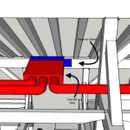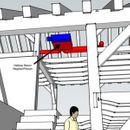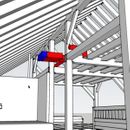Integrating Ducted Mini-Split with HRV
Hello,
I am currently trying to come up with the best solution to heat AND ventilate 3 upstairs bedrooms. I don’t have a ton of space for the mechanical and I am trying to come up with a solution to isolate the systems from the living/sleeping space. I do think I would like to put the HRV unit in the basement and run flex tubing up to the 2nd floor and tie it into the limited short duct runs that will be coming from the slim ducted mini-split unit I hope to install in the ceiling. I feel pretty good about the ducted mini-split installation and short runs of tubing that I have drawn. Additionally, I am planning on using passive returns in the doors to hopefully get everything to flow back to the hallway and into the register/plenum.
A lot of HVAC pro’s are recommending that I need more ductwork (i.e. dedicated returns for each room) but I think I have a fairly reasonable solution. My climate is zone 6 (cold) so I am mostly designing for heat however the bedrooms are west-facing so I am going to have to manage the heat buildup. I am attaching a couple renderings. My main question concerns the ability to attach a fresh air intake on some of these ducted mini-splits. In all my research, I haven’t seen if the units have an integrated “knockout” that might accomodate a fresh-air flex tube. I am thinking I will just fabricate/extend the rear return plenum so that I can have a port/entry/knockout for the HRV. If I do this, my goal will be to make sure that I get clean conditioned air into the rooms. I am hoping the ductwork shown doesn’t have too much static pressure to overcome. Thanks in advance if anyone has any feedback or thoughts.
GBA Detail Library
A collection of one thousand construction details organized by climate and house part













Replies
John,
There are lots of issues here.
First of all, trying to use ductwork designed for delivery of heat to also supply ventilation air is fraught with problems, and GBA advises homeowners and builders to avoid that approach if possible. You really want dedicated ventilation ductwork, totally separate from your heating ductwork, for all kinds of reasons. In your case, for example, you will have two different appliances, each equipped with a fan, each with different controls. You'll never know if the heating system fan is on, the HRV fan is on, or both fans are on at once. That gives you at least three different operating modes to analyze, with different CFM configurations, and with different ways that the air can be accidentally pulled from the wrong appliance. Solve it with motorized dampers? I don't think so.
Second, ducted minisplit systems have low-cfm blowers compared to American forced-air systems, and these ducted minsiplits are finely tuned systems. Throw in another appliance with its own fan, and you don't know what's going to happen. (One thing that's fairly certain is that you will void the minisplit warranty if you don't install the minisplit according to the manufacturer's instructions -- and I don't think that minisplit manufacturers allow their ducts to be shared with other appliances.)
For more information on these issues, seeDesigning a Good Ventilation System.
-- Martin Holladay
Martin,
Sorry to dredge up such an old thread. I'm wondering: does this still hold true? Both Mitsubishi and LG among others now have mid and high static pressure ducted units available - some capable of operating at 1.0 ESP but with most falling in the 0.5 range with up to 1,400 CFM on some of the larger units.
In retrofit applications, we're often going to struggle to find the room to build a full second set of ductwork. Even in a new build I'm working on right now, we could only accommodate one duct system in the design. If we are constrained in that manner, could we find a way to get a ventilation system to work within the supply and return duct systems? Perhaps some kind of damper?
Independently of the blower power on the mini-split cassette, an HRV is a balanced system that has to be tweaked-into balance. With the modulating blower on a mini-split that balance would like change with blower speed.
Ductless HRV can be a reasonable solution. Or ducted.
The duct sizes of HRVs are miniscule compared to typical HVAC ducts, even when running 0.8-1" static pressures on a beefier mini-split. Assuming the HVAC ducting is reasonably balanced (not always a good assumption), a common return can be used for the ventilation system, with only supply registers to the rooms. (no dedicated return duct system.) At typical room ventilation rates and typical door threshold cuts the changes in balance with the doors open vs. closed is also small.
If you put the HRV supply vent physically close to the ducted mini-split return vent, then I would expect the mini-split to do a pretty good job distributing the fresh air to the bedrooms. As long as the mini-split is properly sized, it should be running a high percentage of the time.
If a substantial fraction of the air moved by the mini-split is fresh air, then you probably want to use a remote thermostat. A thermostat built into the mini-split wouldn't be seeing an air temperature representative of the rooms being conditioned.
Will the HRV also be servicing other areas of the house that are not heated by the mini-split?
Even a properly sized mini-split will not be running much of the time. Here in Maine it has been unseasonably warm for February, with temps ranging from about 30 to about 50. My right sized minisplits haven't turned on at all for at least a week. Last year I turned them off in early April. You really need mechanical ventilation in a tight house almost all the time, with the exception of when the windows are open.The minisplit won't circulate ventilation air when it isn't running.
I think trying to coordinate heat/AC with ventilation is probably likely to result in inadequate ventilation much of the time. The optimal duct sizes are different, you need more exhaust return ports for the hrv than return air ducts for the heat.
Thanks for the responses so far. I did find one bit of information in the Fujitsu literature where they state their slim duct units have "the ability to bring in fresh air." Not sure what they mean by that. I will give them a call and see if I can get any clarity. I like the idea of having a fresh air supply register in the hallway but I will see if I can figure out a way to get fresh air to the bedrooms. The Zehnder ComfoTubes appear to be 3" in diameter so perhaps I can run them from a basement manifold up to the 2nd floor. To answer RBaldwin's question, I plan to use a floor mounted Mini Split on the 1st floor and run 2 supply and 1 return on the first floor, which will be an open floor plan. I guess I have more research to do. I do see your point Martin about how the controllers could be working against each other if the systems were integrated. Duly noted. I will re-draw another solution and post it here for more feedback. I would prefer to have the HRV in the basement but I suppose it could be in the attic. Basically, I'm trying to figure out the simplest way to have these systems work effectively.